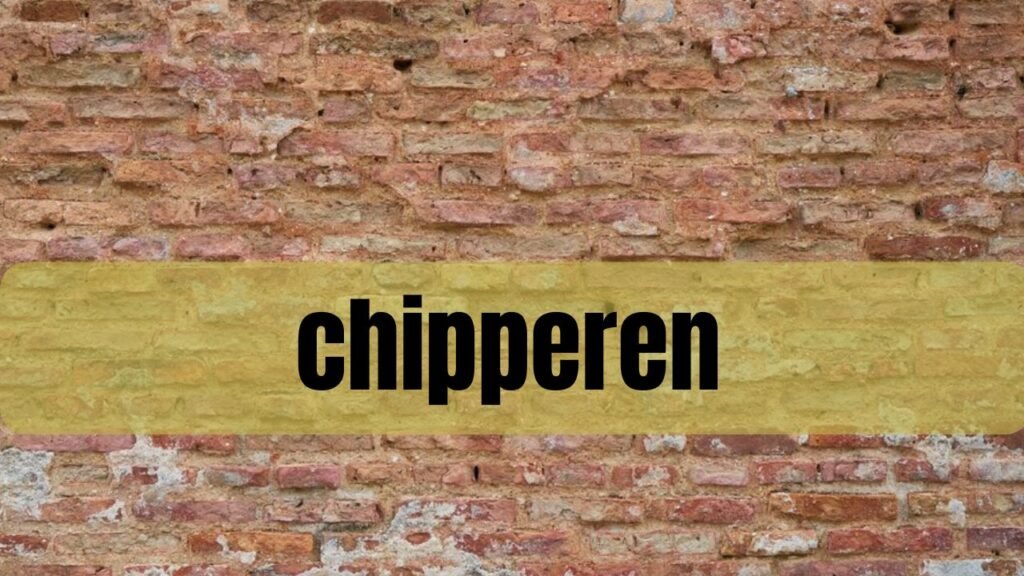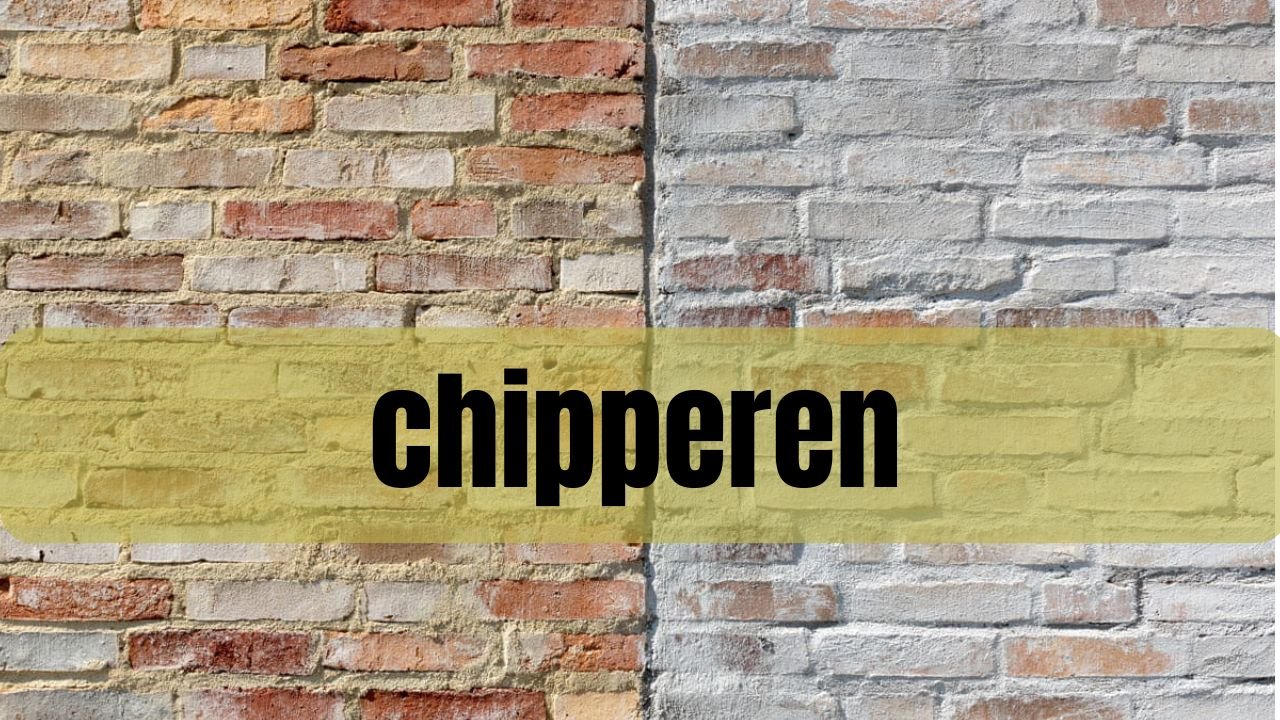Chipperen is a term that resonates with deep cultural and historical significance, encompassing a broad range of traditions, rituals, and customs that have evolved over centuries. In this article, we’ll explore the origins of Chipperen, its traditional practices, and how it continues to shape the cultural identities of communities today. For those curious about this fascinating cultural phenomenon, this in-depth look will offer insight into how Chipperen remains relevant in modern society while staying true to its historical roots.
Table of Contents
What is Chipperen?
At its core, Chipperen is more than just a word—it represents the essence of cultural heritage, passed down through generations. It includes a variety of traditional customs, rituals, ceremonies, and festivals that are deeply interwoven with the social fabric of specific communities. These customs often coincide with significant life events, seasonal changes, or communal celebrations. Understanding Chipperen involves delving into the rich historical context from which it emerged and how it continues to play a central role in modern traditions.
The Historical Origins of Chipperen
Ancient Beginnings of Chipperen
The origins of Chipperen trace back to ancient times when early civilizations used these customs to mark critical events like the harvest, the changing of seasons, or religious observances. It wasn’t merely a set of practices but a way for people to communicate with their environment and the spiritual world. Ancient societies viewed Chipperen as a means to foster a connection between the natural world and the divine, often performed as rituals to ensure successful crops, ward off danger, or bring prosperity to the community.
Evolution Through the Centuries
As societies progressed, so did Chipperen. What started as simple rituals transformed into elaborate ceremonies over time, blending influences from new cultures, religions, and social structures. The dynamic nature of Chipperen traditions showcases their ability to adapt while retaining their original essence. Historical documents and oral traditions show us that while the form of Chipperen may have changed, its purpose—to unite communities and honor their shared heritage—remains steadfast.
Traditional Practices and Customs of Chipperen
Festivals: The Heartbeat of Chipperen
Festivals form the vibrant core of Chipperen celebrations, where communities gather to honor their collective cultural heritage. These festivals are often marked by traditional music, dance, feasting, and artisan displays that highlight the unique aspects of Chipperen culture.
- Music and Dance: Folk dances, rhythmic drumming, and cultural songs are integral to these festivals, reflecting the rich musical traditions passed down through generations.
- Artisan Crafts: These festivals also serve as a platform for showcasing the artistic skills of the community. Crafts such as weaving, pottery, and painting are displayed, preserving the traditional methods of craftsmanship that are intrinsic to Chipperen heritage.
Feasts: A Culinary Celebration
Feasts are a significant part of Chipperen customs, focusing on the preparation and sharing of food that carries deep cultural importance. The dishes served during these events are often family recipes passed down through generations, making these meals not only about nourishment but also about preserving tradition.
- Traditional Dishes: The recipes used for these feasts often come with stories of their origins, with some being considered family secrets due to their historical and cultural significance.
- Communal Eating: The act of coming together to share a meal reinforces social bonds and cultural continuity, emphasizing the collective experience of celebrating Chipperen traditions.
Rituals and Ceremonies
In Chipperen, ceremonies play a crucial role in marking life’s major transitions and the cycles of nature. These rituals often reflect the community’s values and beliefs, creating a shared cultural experience.
- Life Transition Rituals: From birth to coming-of-age ceremonies, marriage, and funerals, Chipperen rituals often mark the key stages in a person’s life. These events are celebrated with customs that symbolize growth, responsibility, and social integration.
- Seasonal Celebrations: Chipperen also encompasses festivals tied to the natural world, like harvest or solstice celebrations. These seasonal events honor the cycles of nature and ensure the community’s harmony with their environment.
The Cultural Importance of Chipperen
Preserving Cultural Heritage
One of the most significant aspects of Chipperen is its role in preserving the cultural identity of a community. Through the continuation of these customs, communities are able to maintain a connection to their past while passing on their traditions to future generations.
- Cultural Identity: Practicing Chipperen fosters a strong sense of identity among participants, helping them remain connected to their roots while navigating modern life.
- Historical Continuity: By preserving Chipperen rituals and ceremonies, communities ensure that their unique traditions are not lost, providing a living link to their history.
Strengthening Community Bonds
A key feature of Chipperen is its ability to bring people together, fostering a sense of unity and belonging. Festivals, feasts, and rituals allow individuals to share experiences, strengthen social ties, and reinforce community cohesion.
- Building Social Connections: The communal nature of Chipperen events offers opportunities for individuals to forge deeper relationships and create lasting social networks.
- Fostering Unity: Participation in Chipperen strengthens the collective identity of the community, promoting a sense of togetherness that transcends individual differences.
Educational Value of Chipperen: A Cultural and Educational Treasure

Chipperen serves an invaluable educational purpose, particularly for younger generations eager to connect with their cultural history and traditions. Through participating in Chipperen activities, individuals acquire important lessons in heritage, traditional practices, and communal values that have been passed down through generations. This rich tradition fosters cultural education and skill development, making it more than just a cultural event — it is a living classroom.
Cultural Education through Chipperen
One of the core elements of Chipperen is the opportunity it offers for younger generations to deepen their understanding of their cultural roots. By engaging in Chipperen activities, participants learn not just about cultural practices but also about the historical context and values that these traditions embody. Whether it’s through storytelling, rituals, or communal gatherings, Chipperen instills a sense of pride and belonging among those who partake in its traditions.
Skill Development in Chipperen
Chipperen is not just about remembering the past; it’s also a means of developing practical skills. Whether it’s traditional crafting, cooking, or performing arts, many aspects of Chipperen require hands-on learning. These skills are often passed down from older members of the community to the younger generation, ensuring that the craft, knowledge, and techniques integral to the tradition are not lost. This type of cultural education not only fosters individual growth but also strengthens communal ties.
Modern Adaptations of Chipperen: Blending Tradition with Contemporary Life
As the world evolves, so too does Chipperen. Despite the changes that modern life brings, Chipperen has managed to retain its traditional essence while adapting to contemporary settings. This adaptation has allowed it to remain relevant in today’s society while still preserving its cultural integrity.
Integration of Chipperen with Modern Lifestyles
In recent years, Chipperen has found innovative ways to integrate with modern life. Communities have successfully blended traditional Chipperen practices with contemporary elements, ensuring that younger generations remain engaged while also attracting a broader, more diverse audience. These changes have allowed Chipperen to thrive in an increasingly globalized world, where maintaining cultural relevance can often be a challenge.
Modern Chipperen Festivals
Today’s Chipperen festivals often incorporate modern elements, ranging from new music genres and contemporary art forms to cutting-edge technology. These festivals are not just a throwback to the past but a vibrant celebration of how tradition can evolve. By introducing contemporary forms of expression, such as modern dance, visual arts, and fusion cuisine, Chipperen appeals to a younger audience while still preserving the core values of the tradition.
Contemporary Art in Chipperen
A key feature of modern Chipperen festivals is the inclusion of contemporary art, which blends traditional forms with modern interpretations. This artistic fusion allows Chipperen to reach a wider audience, encouraging cultural appreciation from people who may not be familiar with its historical roots. It also offers an opportunity for artists to explore their cultural identity in innovative ways.
Technology’s Role in Chipperen Events
Technology has become an essential tool in modern Chipperen celebrations. From organizing events to promoting festivals through digital platforms, technology has made Chipperen more accessible. Social media platforms like Instagram, Facebook, and YouTube play a crucial role in sharing Chipperen traditions with a global audience, allowing people from around the world to engage with this rich cultural heritage.
Digital Platforms and Chipperen: Expanding the Reach of Tradition
As with many cultural traditions, Chipperen has embraced the digital age. By leveraging digital platforms, communities can now share information, plan events, and connect with others in ways that were never before possible. This online presence has helped keep the tradition alive and thriving, ensuring that it continues to grow in popularity.
The Role of Social Media in Promoting Chipperen
Social media platforms have become indispensable in promoting Chipperen. Through posts, videos, and live streams, communities are able to share the details of their festivals, rituals, and cultural practices with a global audience. This increased visibility has allowed Chipperen to reach people who may never have had the opportunity to experience these traditions firsthand.
Online Communities Supporting Chipperen
Beyond social media, there are also online communities and forums that focus on preserving and promoting Chipperen. These digital spaces serve as hubs for information, discussion, and collaboration, allowing people to share resources and exchange ideas on how best to maintain and evolve this cherished tradition. These online platforms are crucial in keeping the spirit of Chipperen alive in a rapidly changing world.
Challenges and Opportunities: Balancing Tradition with Modernity in Chipperen
While modernizing Chipperen has provided many opportunities, it also brings challenges. The key to maintaining Chipperen’s relevance in today’s world lies in balancing tradition with innovation. Communities must navigate the delicate task of integrating modern elements without losing sight of the core values that make Chipperen unique.
Maintaining the Integrity of Chipperen Traditions
One of the biggest challenges in modernizing Chipperen is ensuring that traditional practices remain true to their origins. While adaptation is necessary to keep the tradition relevant, it’s essential that the authenticity and cultural significance of Chipperen are not compromised. Communities must carefully balance innovation with tradition to ensure that the heart of Chipperen remains intact.
Preserving Cultural Heritage in a Modern World
As Chipperen continues to evolve, it’s critical to preserve its cultural significance and historical roots. This preservation is not just about safeguarding the past; it’s also about ensuring that future generations can connect with their heritage. By maintaining the integrity of Chipperen’s core practices, communities ensure that this rich cultural tradition will continue to thrive.
Chipperen in Comparison to Other Cultural Traditions
Similarities with Other Traditions
Like many cultural traditions, Chipperen places a strong emphasis on preserving heritage and fostering community connections. It shares similarities with other traditions in its focus on cultural preservation and communal bonding, particularly through shared festivals, rituals, and educational practices.
Differences that Set Chipperen Apart
While Chipperen shares commonalities with other cultural traditions, it is also unique in its practices, regional variations, and its specific response to modernity. These differences highlight the distinctiveness of Chipperen and its importance in the broader cultural landscape.
Regional Variations of Chipperen
One of the distinguishing features of Chipperen is its regional variations, which reflect the specific cultural contexts in which it has developed. These differences give Chipperen its unique character and allow it to be a dynamic and adaptable tradition.
Evolution of Chipperen Compared to Other Traditions
Chipperen’s evolution in the face of modernity differs from how other traditions have adapted. Its ability to integrate modern elements while staying rooted in tradition is a testament to its resilience and ongoing relevance.
Conclusion: The Ongoing Legacy of Chipperen
Chipperen is more than just a tradition — it is a living, evolving aspect of cultural identity. Through its festivals, rituals, and digital presence, Chipperen provides educational opportunities, fosters community engagement, and preserves cultural heritage. As it continues to adapt to the modern world, Chipperen remains a vibrant and essential part of the communities that cherish it.
By exploring Chipperen’s past, present, and future, we gain a deeper appreciation for the richness of cultural traditions and the importance of preserving them. Understanding Chipperen helps us recognize the value of heritage, the significance of community, and the enduring power of cultural practices in shaping our identities.Frequently Asked Questions (FAQs) About Chipperen
1. What is Chipperen?
Chipperen is a cultural tradition that involves various activities, rituals, and festivals aimed at preserving and celebrating a community’s heritage. It provides educational opportunities for younger generations to learn about their cultural history, traditional practices, and values passed down through generations.
2. How does Chipperen contribute to cultural education?
Chipperen offers a unique way for younger generations to understand their cultural heritage. Through participation in Chipperen activities, individuals learn about traditional customs, historical contexts, and the values that define their community. It serves as an ongoing educational experience, ensuring that cultural knowledge is preserved and passed down.
3. What kinds of skills can be learned through Chipperen?
Engaging in Chipperen traditions often involves learning hands-on skills such as traditional crafting, cooking, and performing arts. These skills are typically passed down from older generations and help preserve the practical aspects of cultural heritage while promoting personal growth and community involvement.
4. How has Chipperen adapted to modern life?
Chipperen has successfully integrated contemporary elements while maintaining its traditional essence. Modern festivals celebrating Chipperen may feature new music genres, contemporary art, and technology, helping attract a broader audience while preserving the core values of the tradition. Digital platforms and social media have also played a crucial role in expanding its reach.
5. How does technology impact modern Chipperen celebrations?
Technology has become integral to modern Chipperen events. Digital platforms are used to organize festivals, promote cultural traditions, and engage a global audience. Social media, in particular, has amplified the visibility of Chipperen, allowing communities to share information, connect with others, and engage with a wider audience.
6. What role do digital platforms play in preserving Chipperen?
Digital platforms, including websites, online communities, and social media, help preserve and promote Chipperen practices. These platforms provide a space for sharing resources, discussing traditions, and organizing events, ensuring that the knowledge and significance of Chipperen are accessible to a global audience.
7. What challenges does Chipperen face in modernizing its traditions?
One of the main challenges Chipperen faces is maintaining the integrity of its traditional practices while integrating modern elements. Balancing innovation with cultural preservation is essential to ensuring that Chipperen remains authentic and meaningful, even as it adapts to contemporary life.
8. How does Chipperen compare to other cultural traditions?
Like many other cultural traditions, Chipperen emphasizes the importance of preserving heritage and fostering community connections. However, Chipperen is unique in its specific practices, regional variations, and the way it has evolved in response to modernity. These differences set it apart within the broader landscape of cultural traditions.
9. What are the regional variations of Chipperen?
Chipperen traditions may vary based on the region or community in which they are practiced. These regional variations reflect the local history, values, and cultural contexts that have shaped the tradition over time, adding richness and diversity to the practice of Chipperen.
10. Why is it important to preserve Chipperen?
Preserving Chipperen is essential for maintaining cultural heritage and ensuring that future generations can connect with their history and identity. As Chipperen evolves, it’s crucial to maintain its core values and practices, ensuring that its cultural significance remains intact even as it adapts to a modern world.
11. How does Chipperen help foster community bonding?
Chipperen plays a significant role in bringing communities together through shared festivals, rituals, and educational practices. By participating in Chipperen, individuals strengthen their communal ties, foster relationships, and build a collective sense of identity, making it a vital aspect of community life.
12. Can anyone participate in Chipperen festivals?
While Chipperen is rooted in the traditions of specific communities, many modern festivals are open to a broader audience. By integrating contemporary elements and promoting events through digital platforms, Chipperen festivals now attract diverse groups of people who are interested in experiencing and learning about this cultural tradition.
You can see latest news and updates at: Secret Class



